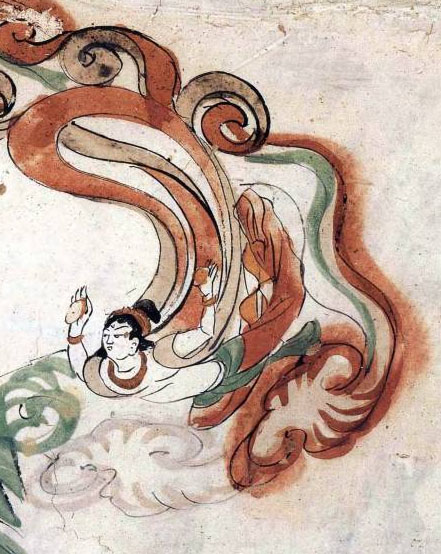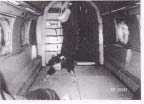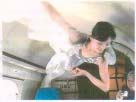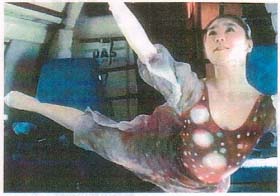Setsuko Ishiguro – The ‘Flying Deities Project’: An attempt at performing East Asian ancient dances in zero gravity environments – 2004
Artist
First publication workshop Space: Science, Technology and the Arts in collaboration with ESA/ESTEC, 2004
Introduction
As activities in space become more common, it is increasingly important to examine human behavior in zero gravity from the viewpoint of arts and culture. This study examines the performance of certain dances in a zero gravity environment, and makes a comparison between such performances and what ancient people imagined it to be like dancing in this kind of environment. Among the many cultures that have imagined flying celestial beings, this study focuses on the murals of flying deities [hiten] in Dunhuang (China) and Asuka (Japan).
For this project, On Hayashi from the Fine Arts Division of the Agency for Cultural Affairs (Japan), who is the leading figure in research on the murals of flying deities, prepared various images arranged from the standpoint of dance expression. Together with Setsuko Ishiguro, who both studies and performs dances at the Graduate School of Ochanomizu University (Japan), he chose images that could be used in choreographing for a performance in zero gravity. With regard to music Ouji Chin, Professor at the Shanghai Music Academy (China) and Hiroo Hiedo, from the East Asia Gugin Learning Laboratory (Japan) examined music in ancient China and analyzed the structure of the music that may have accompanied the flying deities. Indeed, Mr. Chin is an authority on this subject and is widely known for deciphering the musical score for Dunhuang lutes.
Following the examination of the movements and music of the flying deities, discussions were held with the Chinese Dance Academy in China. Then the choreography and music composition for re-enacting the dance of the flying deities in zero gravity were decided upon. By defining these conditions, it became possible to move to the next step, that is commissioning the music composition. Akihiro Kubota from Tama Art University in Tokyo was in charge of exploring the possibilities of transfiguration through the acquisition of images and the utilization of information technology to perfect the artistic quality.
Before we move on to the details of this project, we need to clarify what we mean by ‘flying deities.’ In the Buddhist tradition the flying deities are regarded as celestial beings who fly through the air to praise Buddha’s dignity and guard his world. More specifically, they ‘rejoice over Buddha’s doings by performing music, showering flowers and
wafting incense as they fly through the air’ [1]. The flying deities in the Buddhist tradition have their origins in India from where they were brought to China. The most beautiful images of them are found in the grottoes of Dunhuang and Yungang (China). This paper focuses on Dunhuang cave art and analyzes the physical characteristics and dance postures of these figures of flying deities. Moreover, depictions of flying deities in Japan are considered, in particular those of the murals from the Horyuji Golden Hall.
Flying deities in Dunhuang cave art and dance
The flying deities depicted in the murals of Dunhuang count 4,500 in the Mogao Grottoes alone [2],[3]. If we were to include those in the Yulin and Xi Qian Fo caves, it would be almost impossible to count them all. Comparing the flying deities in the Mogao Grottoes with those painted in other grottoes, more variation in postures can be seen in the Dunhuang cave art. This variation in movements is one of the main characteristics of the flying deities in Dunhuang cave art.
The way the flying deities are painted can be divided roughly into three periods showing the development of Dunhuang cave art according to the postures of the deities when they fly[4].
The first stage refers to the images spanning from the Northern Liang period (397–439) to the Western Wei period (535–556). It starts with the powerful flying deities whose bodies are bent in the shape of the letter U in cave 257, moving on to the flying deities hovering around a tower in cave 254 and finally leading up to the flying deities in airy postures in cave 285. Hence, we start with the imagery of calm strength, which then changes into more dynamic yet soft images with the deities floating and hovering in the air, and finally reach something more graceful altogether. It is an enriching process through which the characteristics inherent to the Ujin [winged beings] in Huabei (the middle reaches of the Yellow River in China) and the flying deities of the Southern Dynasties(420–589) merge together with the characteristics of the flying deities of Western China.
During the second period, spanning four hundred years from the Northern Zhou period (557–581) to the Tang period (618–907), the Dunhuang flying deities flourished most. The style evolved in many ways including the variation in their postures, facial expressions and the momentum of their movements. Hence, the airy quality of their dance-like movements was no longer limited to the moment they jumped up into the air. The rhythm of the movements, from slow to quick and vice versa, changed according to a certain rule whilst at the same time the movements acquired vigorousness. Regarding the figures of the deities in the Tang period, they tend to be more robust and voluptuous than those of the previous period.
The flying deities in cave 428 are called Dao Ti Zi Jin Guan [wearing a golden, purplish crown] and they look as if they are standing on their hands in mid-air like flowers, and lift their heads to play the flageolet. In cave 290, there are flying deities offering flowers with both hands. Deities in both caves have expressive faces and are wearing beautiful silk clothes. Instead of succeeding the exquisite decorum of the Sui period (618–907), the flying deities in the early Tang period have a refreshing spirit of fortitude. The flying deities of Dunhuang cave art reached their height in the Tang period with their colorfulness and opulent beauty, examples of which can be seen in caves 220, 57, 320 and 25. (see fig. 1. Cave 220)
During the third phase, starting from the period of the Five Dynasties (907–960) to the Yuan period (1227–1368), the postures of the deities flying become even more varied, yet they lose the lively and vibrant quality that was manifest before.
Characteristic postures of the flying deities are expressed through the way they stir and look down. Especially from the Northern Wei period to the Yuan period, the flying deities ‘look down while lifting their upper bodies’ [5]. This posture is not commonly seen in the flying deities of India and differentiates the Dunhuang deities from the Indian ones. In addition there is more airiness and brightness to the Dunhuang deities compared to their Indian counterparts. Many statutes and murals created in the Han period (former Han period 202 BC–8AD, later Han period 25–220AD) are also modelled in this posture. Some point to the ties with the Chinese contortion (circus), a genre of traditional performing arts in China, where the performers frequently stand on their hands.
Other ways of expressing the beauty of the deities’ dancing as they fly include the usage of various props [6].Thus, for example, flowers and silk clothes painted in the murals enliven the movement of the flying deities, while the floating clouds and spinning of flowers in mid-air are conveying emotions. This tradition is continued in the paintings of the Han period too. The flying deities in Dunhuang cave art are therefore considered to be the consummation of the art of dancing and at their heart lies the wisdom of Chinese civilization. Moreover, the depictions of the deities dancing and floating in mid-air have been the result of the beauties of fine arts, dance and silk coming together as one.

Images of flying deities in Japan
During the Sui and early Tang periods in China, Japan was in the middle of the Asuka period (538–660). In art history, the Asuka and Hakuho periods (660–710) are important because Buddhist art flourished then. At the time, much was absorbed from China via the Korean Peninsula, making it a rewarding period for the images of the flying deities. To this day, the Japanese feel most familiar with the flying deities of this period. We will now examine one of the most famous works of this period.
Murals from the Horyuji Golden Hall
The murals from the Horyuji Golden Hall [7]seem to date back to the late seventh to early eighth century. In art history, this time is called the Hakuho period, when Emperor Ten’mu and Empress Jito eagerly imported Buddhism and the Chinese legal system. In the field of figurative art, a new art style was introduced epitomized in Buddha statues resembling a youthful man. The murals from Horyuji Golden Hall and the sculpture from Yakushiji Golden Hall [8]are works that represent the beauty of this period. In particular, the murals from Horyuji Golden Hall were magnificent, but most of the paintings were lost in a fire in 1949. Fortunately, the walls with the images of the flying deities had been removed before the fire.
The same pattern appears on the sixteen walls that were saved from the fire: two deities together flying from the left to the right, showering flowers. With their upper bodies erect and head thrown back, they are seen from above. Their faces and upper bodies are painted from the front while from the hips to the toes they are painted from the back. The painted line is tense and the deities’ postures emanate grace. The portrayal of the long scarves that flatter in the wind is simply breathtaking.
Flying deities similar to the ones painted in the Horyuji Golden Hall can also be seen in works from the early Tang period, for example, in cave 220 of the Dunhuang Mogao Grottoes (see fig. 1.). However, in the murals of Dunhuang, dynamism is strongly emphasized by the mobility derived from the flowers and clouds painted around the flying deities whose posture, as we have seen above, may be described as ‘looking down while lifting their upper bodies.’ In contrast, the flying deities in the murals of Horyuji Golden Hall can be said to be more gentle and two-dimensionality is emphasized whilst also creating an unworldliness.
Creating a dance in zero gravity
Amongst the postures of flying deities seen in the murals of Dunhuang, those from the early Tang period are said to have developed a style unique to Chinese culture, independent from the influences of India and Uighur[9]. There are also indications that this style has influenced the flying deities in Horyuji in Japan. For this reason, the dance of flying deities we aimed to create was based on the postures from this period.
Postures
According to Hijiu Dang (1993), a researcher on Dunhuang dances, dance movements before the Sui period were very similar to Indian dances and showed many traces of foreign influence. After that, movements, fashion and facial expressions become more unique and, as a result, the basic postures of the body are defined, as with the positions of the hands.
The Tian Gong Ji Le [Buddhist saints who play music in heaven] in cave 288 (Northern Wei) and Ji Le Bodhisattvas [music played by the Tennin, the heavenly people] in cave 205 (early Tang) differ strongly in their facial expressions and composition. Whereas the former is characterized by influences from the dances of India and Uighur, the latter has definite influences from Central China. Nevertheless, the postures and the ways the silk scarves are used show many similarities. We therefore decided that the dance posture must be in the shape of the letter S showing various curves rather than the posture of classical ballet characterized by a straight vertical line.
Feet
The dancers must perform with bare feet. The feet should form the shape of Gou [lifting the toes], the shape of Beng [arching the back of the feet], or the shape of Wai [lifting the toes at an angle].
Control of leg movements
Based on the images in caves 156, 308 and 465, there are three characteristics in the leg movements. Firstly, the leg being thrust forward at an angle. Secondly, the leg thrust at the side of the body And thirdly, the leg thrust back at an angle.
Hands
The movements and positions of the hands form a vital part of Dunhuang dances. Each hand gesture is inseparable from movements such as hanging down, lifting, tilting, turning skyward, putting them together and rotation. As shown in figure 8, there are seventeen different shapes. Although each shape has a name, the meaning of each one so far has not been clear. However, the shapes can be put into three main categories: shapes that have religious meaning, shapes that show the state of having something and shapes of praying for peace by joining the palms of the both hands [10].
Breath control and eye movements
Whereas the deities’ expression of the eyes in the murals is explicit, breath control is not. By repeatedly copying the stationary position, the basic S-shaped alignment of the body is created by calming the dancers’ breathing. Taking into consideration the breath control of different genres of dance, we have estimated the speed and rhythm of the breathing for each movement. If the rhythm is in four-time, then one inhales at the first two times, and exhales at the next two times sinking lower. The speed is slow and the rhythm clam. By contrast, in the performance of a robust dance, the dancer inhales at the end of the second and fourth times, exhales at the first and third times, and the gravity point of the body sinks below. The movement must be made swiftly and the rhythm is fiery.
From the murals, the eye movements can be classified into four categories based on the directions of the eyes: forward middle, forward low (right/left), forward high or left/right high and forward middle (left/right). With every eye movement, the dancers [bodhisattvas] must give either a gentle or a lively and clear look.
In the training for performing Dunhuang dances the main focus must therefore be on breath control and eye movements. Through breath control, the strength, flexibility and speed of the movements must be balanced and adjusted, while eye movements express rich emotions leading the dancers to the ideal world.
Jump and spin
Two types of ‘jump and spin’ can be distinguished. First, the characteristic jumps of Shuang Fei Yan. Second, the spins of Hu Xuan dance in which the left leg swings swiftly through the front of the dancer’s body, from left to right, and, by using the momentum, the body spins around making three steps backwards, and vice versa.
Performance in zero gravity
Two parabolic flights were made to test the performance of flying deities in zero gravity. For this purpose the test subjects, who were two skilled female modern dancers, boarded an airplane to simulate elements of the performance in zero gravity.
One major aim of this test performance was to define the basic patterns for the dance and the task was to look down as the dancer lifted the upper body. Another aim consisted of defining the basic patterns for a duo dance, one resembling those of the mural paintings of Horyuji and another one similar to those of Dunhuang. This required coordinated movements between the two dancers such as the usage of silk scarves and the throwing of flowers.
The first flight proved difficult for the test subjects to familiarize with zero and double gravity environments. For this reason, they could barely take up the posture of looking down while lifting their upper bodies (see fig. 2. ). During the second flight, attempts were made to take up postures similar to the ones depicted in the murals at Horyuji and Dunhuang, and to throw flower-like objects between the test subjects (see fig. 3. and 4. ).
The following points became apparent as a result. Firstly, it is relatively easy to bend the body forward and backward, forming the shape of the letter U. Secondly, movements in midair resemble the movements of fish in water. Thirdly, the effects of silk scarves were limited because there was no wind and hence a need to devise something else. Finally, the utilization of props, such as a flower-like object used on this occasion, should follow its own, independent track. During the performance in zero gravity, the flower-like object, equipped with a sensor to prevent contact with the walls, was a success since it rotated on its own showing a beautiful track.
Conclusion
The image of the flying deities is an element of Buddhist art that traveled from India, China, Korea on to Japan. A prime characteristic of the flying deities is that they are celestial beings. A second one is that they rejoice in Buddha’s effort to save mankind. Symbolically their existence celebrates and lauds mankind’s progress towards the world above. In this regard, they play a role similar to that of angels in the Christian tradition. Flying deities shower flowers from the sky, perform a variety of music and give encouragement and inspiration to mankind.
One of the most prominent characteristics of the postures of flying deities is ‘looking down while lifting upper bodies.’ As we have seen above, the postures of flying deities in the murals of Dunhuang are solid and three-dimensional compared to those in Japan that are flatter and two-dimensional whilst being characterized by unworldliness and stillness. Moreover, it has become evident that the postures of the Dunhuang dance, which are composed of various curves depict the shape of letter the U and not the straight vertical line emphasized in classical ballet.
In zero gravity, one normally moves forward as if exposed to danger. Trained dancers, however, can float in this environment bending their upper body backward like the flying deities were painted in ancient times. Thus, it became clear that a posture of bending backward is one of the artistic rules in zero gravity.
The above described attempts at re-enacting a dance of the flying deities in zero gravity shows that, despite some of the mentioned difficulties, this offers a possibility of realizing ancient people’s adoration of the celestial world, and also provides important clues in studying effective movements in zero gravity.



Professor Setsuko Ishiguro, dance scholar and modern dance choreographer/performer, teaches dance aesthetics, modern dance technique and composition to undergraduate and graduate students in Graduate School ofHumanities and Sciences, Ochanominizu University in Japan. Professor Ishiguro received Agency for Cultural Affairs Art Festival Award twice in 1985 and 1987. She is the author of Origin of the Dance-Figures of Ancient India (1997, Tokyo), Dance as Image Communication (1989, Tokyo).
References
[1] Flying Deiies. The Grea Japanese Dictionary . Tokyo: Kodansha,p.182, 1995.
[2] ‘Museum Mural Painting Tomb of Southern Dynasty,’ in Jiang Su Dan
Yang Hu Qiao. Chinese Things, vol. 2,p.2, Nan Jing ,1974.
[3] Shuhong, Li, ‘Research on mural painting of Jiang Su Dan Yang,’ in Chinese Things, vol. 1.p.1,1977.
[4] Wen jie, Duan, ‘The nation’s tradition and influence from overseas in ancient mural painting of Dunhuang,’ in Chinese Things, vol. 12,1978.
[5] Xijiu, Don, Dunhuang dancing. Xin Jiang. Xin Jian Arts publication,1993,p,73.
[6] Shuong, Chang and Cheng Xian, Li, Dunhuang Fei Tian Arts in world, vol. 11.,1986.
[7] Horyuji, in Nara, is the first temple in Japan registered by the UNESCO as a ‘World Cultural Heritage’ in December 1993. Horyuji is composed of the Western Precinct [Saiin Garan] and the Eastern Precinct [Toin Gn]; the Golden Hall is located in the Western Precinct.
[8] Yakushiji Golden Hall is a temple in Nara established by Emperor Ten’mu in the Asuka area to pray for healing for the Empress in the Hakuho period.
[9] Uighur is Turkish-speaking people of Central Asia who live largely in northwestern China.
[10] Xijiu, Don, Dunhuang daning. Xin Jiang. Xin Jian Arts publication,1993,p,140.
© Setsuko ISHIGURO & Leonardo/Olats, mai 2004, republished 2023
Leonardo/Olats
Observatoire Leonardo des Arts et des Techno-Sciences
À propos / About | Lettre d'information Olats News



Pour toute (re)publication, merci de contacter / For any (re)publication, please contact Annick Bureaud: info@olats.org
Pour toute question concernant le site, merci de contacter / For any issue about the website, please contact: webmaster@olats.org
Design Thierry Fournier
© Association Leonardo 1997-2022